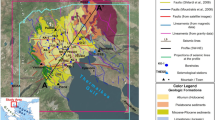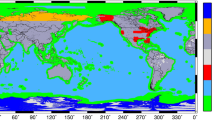Abstract
Seismic Moho depth is defined based on a significant seismic velocity change between the crust and the upper mantle. Receiver function studies provide the most reliable estimates of the Moho depth. However, they are limited to some profile strikes to the Zagros collision zone. Here, we present an automated inverse methodology to provide a 3D Moho relief beneath the Zagros collision zone. We use gravity data in a vast square to compute the Moho depth model to refine an initial Moho depth model obtained from shear wave tomography. The depths, estimated by long wavelength shear wave tomography initially derived for the entire Middle East, are considered for the initial depth model. This initial model is refined by using a very popular and robust method for nonlinear inversion accessible through open-source resources in Python. Our modeling results indicate that only a 100 kg/m3 density contrast between the crust and the upper mantle is sufficient to provide the Moho depth values comparable to receiver functions. This is interpreted as the high density and mafic affinity of the lower crust beneath the Zagros collision zone. It appears the lower crust returns to eclogite in the deep part. Alternatively, the cratonic core of the Zagros keel has a small density leading to only a 100 kg/m3 density contrast between the lower crust and the uppermost lithospheric mantle. The depths obtained by our inversion methodology are compared and assessed to other studies in the area of Moho relief modeling.






Similar content being viewed by others
Data Availability
No new data were generated or analyzed in support of this research.
References
Alavi, M. J. T. (1994). Tectonics of the Zagros orogenic belt of Iran: New data and interpretations. Tectonophysics, 229(3–4), 211–238.
Amante, C., & Eakins, B.W. (2009). ETOPO1 arc-minute global relief model: procedures, data sources and analysis. NOAA Technical Memorandum NESDIS NGDC-24, 19 pp.
Berberian, M. (1995). Master “blind” thrust faults hidden under the Zagros folds: Active basement tectonics and surface morphotectonics. Tectonophysics, 241(3–4), 193–224.
Berberian, M., & King, G. C. P. (1981). Towards a paleogeography and tectonic evolution of Iran. Canadian Journal of Earth Science, 18, 210–265. https://doi.org/10.1139/e81-019
Bott, M. H. P. (1960). The use of rapid digital computing methods for direct gravity interpretation of sedimentary basins. Geophysical Journal International. https://doi.org/10.1111/j.1365-246X.1960.tb00065.x
Cordell, L., & Henderson, R. G. (1968). Iterative three-dimensional solution of gravity anomaly data using a digital computer. Geophysics, 33(4), 596–601. https://doi.org/10.1190/1.1439955
Cui, Y. .-A., Zhang, L., Zhu, X., Liu, J., & Guo, Z. (2020). Inversion for magnetotelluric data using the particle swarm optimization and regularized least squares. Journal of Applied Geophysics, 181, 104156. https://doi.org/10.1016/j.jappgeo.2020.104156
Dehghan, M. J., Ardestani, V. E., & Dehghani, A. (2021). Moho topography estimation using interactive forward modeling of gravity data. Journal of Earth and space physics, 47(2), 225–39.
Dehghani, G.A., & Makris, J. (1983). The gravity field and crustal structure of Iran, In: Geodynamics project (traverse) in Iran. Geological Survey of Iran, Rep. No. 51, 51–68.
Ebadi, S., Barzaghi, R., Safari, A., & Bahroudi, A. (2019). Evaluation of different gravimetric methods to Moho recovery in Iran. Annals of Geophysics. https://doi.org/10.4401/ag-8054
Eshagh, M. (2014). Integral developments of Vening Meinesz-Moritz formula for local determination of Moho discontinuity and their applications in Iran. Geodynamics Research International Bulletin, 2(3), I–IX.
Fedi, M., Florio, G., & Cascone, L. (2012). Multiscale analysis of potential fields by a ridge consistency criterion: The reconstruction of the Bishop basement. Geophysical Journal International, 188(1), 103–114. https://doi.org/10.1111/j.1365-246X.2011.05259.x
Feng, X., Wang, W., & Yuan, B. (2018). 3D gravity inversion of basement relief for a rift basin based on combined multinorm and normalized vertical derivative of the total horizontal derivative techniques. Geophysics, 83(5), G107–G118. https://doi.org/10.1190/geo2017-0678.1
Florio, G. (2020). The estimation of depth to basement under sedimentary basins from gravity data: Review of approaches and the ITRESC method, with an application to the Yucca Flat Basin (Nevada). Surveys in Geophysics, 41, 935–961. https://doi.org/10.1007/s10712-020-09601-9
Heydarizadeh Shali, H., Sampietro, D., Safari, A., Capponi, M., & Bahroudi, A. (2020). Fast collocation for Moho estimation from GOCE gravity data: The Iran case study. Geophysical Journal International, 221(1), 651–664.
Ho, T., Priestley, K., & Debayle, E. (2016). A global horizontal shear velocity model of the upper mantle from multimode Love wave measurements. Geophysical Journal International, 207, 542–561. https://doi.org/10.1093/gji/ggw292
Javan-Doloei, G. (2002). Teleseismic P-wave receiver functions and its application on the crust and uppermost Mantle structure estimation. Research Bulletin of Seismology and Earthquake Engineering, 4(4), 21–28.
Jegen, M. D., Hobbs, R. W., Tarits, P., & Chave, A. (2009). Joint inversion of marine magnetotelluric and gravity data incorporating seismic constraints: Preliminary results of sub-basalt imaging off the Faroe Shelf. Earth and Planetary Science Letters, 282(1–4), 47–55. https://doi.org/10.1016/j.epsl.2009.02.018
Kaviani, A., Paul, A., Moradi, A., Mai, P. M., Pilia, S., Boschi, L., Rümpker, G., Lu, Y., Tang, Z., & Sandvol, E. (2020). Crustal and uppermost mantle shear-wave velocity structure beneath the Middle East from surface-wave tomography. Geophysical Journal International. https://doi.org/10.1093/gji/ggaa075
Levenberg, K. (1944). A method for the solution of certain non-linear problems in least squares. Quarterly of Applied Mathematics., 2(2), 164–168.
Li, Y., & Oldenberg, D. W. (1996). 3-D inversion of magnetic data. Geophysics, 61, 394–408.
Marquardt, D. (1963). An algorithm for least-squares estimation of nonlinear parameters. SIAM Journal on Applied Mathematics., 11(2), 431–441.
Martins, C. M., Lima, W. A., Barbosa, V. C. F., & Silva, J. B. C. (2011). Total variation regularization for depth-to basement estimate: Part 1—mathematical details and applications. Geophysics. https://doi.org/10.1190/1.3524286
Molinaro, M., Zeyen, H., & Laurencin, X. (2005). Lithospheric structure beneath the south-eastern Zagros Mountains, Iran: Recent slab break-off? Terra Nova, 17, 1–6. https://doi.org/10.1111/j.1365-3121.2004.00575.x
More, J. J. (1977). The Levenberg-Marquardt algorithm: Implementation and theory. In G. A. Watson (Ed.), Numerical analysis, lecture notes in mathematics 630 (pp. 105–116). Springer Verlag.
Motaghi, K., Tatar, M., Priestley, K., Romanelli, F., Doglioni, C., & Panza, G. F. (2015). The deep structure of the Iranian Plateau. Gondwana Research, 28(1), 407–418.
Motavalli, S. H., Zeyen, H., Brunet, M. F., & Ardestani, V. E. (2011). Crustal and lithospheric structure of the Alborz Mountains, Iran, and surrounding areas from integrated geophysical modeling. Tectonics. https://doi.org/10.1029/2011TC002934
Mousavi, N., & Ebbing, J. (2018). Basement characterization and crustal structure beneath the Arabia-Eurasia collision (Iran): A combined gravity and magnetic study. Tectonophysics, 731–732, 155–171.
Mousavi, N., & Fullea, J. (2020). 3D thermochemical structure of lithospheric mantle beneath the Iranian plateau and surrounding areas from geophysical-petrological modeling. Geophysical Journal International, 222(2), 1295–1315. https://doi.org/10.1093/gji/ggaa262
Mousavi, N., Fullea, J., Shafaii Moghadam, H., & Griffin, W. L. (2023). Mantle compositional structure and dynamics of the Arabia-Eurasia collision zone: Insights from integrated thermochemical modeling. Gondwana Research (in revision)
Oldenburg, D. W. (1974). The Inversion and Interpretation of gravity anomalies. Geophysics, 39(4), 526–536.
Parker, R. (1972). The rapid calculation of potential anomalies. Geophysical Journal, 31(4), 447–455.
Paul, A., Hatzfeld, D., Kaviani, A., Tatar, M., & Pequegnat, C. (2010). Seismic imaging of the lithospheric structure of the Zagros mountain belt (Iran). Geological Society, London, Special Publications, 330(1), 5–18.
Paul, A., Kaviani, A., Hatzfeld, D., Vergne, J., & Mokhtari, M. (2006). Seismological evidence for crustal- 26 scale thrusting in the Zagros mountain belt (Iran). Geophysical Journal International, 166, 227–237. https://doi.org/10.1111/j.1365-246X.2006.02920.x
Pluff, D. (1976). Gravity and magnetic fields of polygonal prisms and application to magnetic terrain corrections. Geophysics, 41, 727–741.
Priestley, K., McKenzie, D., Barron, J., Tatar, M., & Debayle, E. (2012). The Zagros core: Deformation of the continental lithospheric mantle. Geochemistry, Geophysics, Geosystems, 13, Q11014. https://doi.org/10.1029/2012GC004435
Rahmani, M., Motaghi, K., Ghods, A., Sobouti, F., Talebian, M., Ai, Y., & Chen, L. (2019). Deep velocity image of the north Zagros collision zone (Iran) from regional and teleseismic tomography. Geophysical Journal International, 219, 1729–1740. https://doi.org/10.1093/gji/ggz393
Reid, A. B., Allsop, J. M., Granser, H., Millett, A. J., & Somerton, I. W. (1990). Magnetic interpretation in three dimensions using Euler deconvolution. Geophysics, 55(1), 80–91. https://doi.org/10.1190/1.1442774
Salem, A., Williams, S., Fairhead, J., Ravat, D., & Smith, R. (2007). Tilt-depth method: a simple depth estimation method using frst order magnetic derivatives. Lead Edge, 26(12), 1502–1505. https://doi.org/10.1190/1.2821934
Sampietro, D. (2016). Crustal modelling and Moho estimation with GOCE gravity data. In T. Ten (Ed.), Remote sensing advances for earth system science (pp. 127–144). Springer.
Schmdit, S., Götze, H. J., Fichler, C., & Alver, M. (2010). IGMAS+ a new 3D gravity, FTG and magnetic modeling software (pp. 57–63). Geoinformatik.
Snyder, D. B., & Barazangi, M. (1986). Deep crustal structure and flexure of the Arabian plate beneath the Zagros collisional mountain belt as inferred from gravity observations. Tectonics, 5, 361–373.
Stocklin, J. (1968). Structural history and tectonics of Iran: A review. American Association of Petroleum Geologists Bulletin, 52, 1229–1258.
Sun, J., & Li, Y. (2015). Multidomain petrophysically constrained inversion and geology diferentiation using guided fuzzy c-means clustering. Geophysics, 80(4), ID1–ID18. https://doi.org/10.1190/geo2014-0049
Tatar, M., 2001. Etude seismotectonique de deux zones de collision continental: le Zagros Central et l’Alborz (Iran). PhD. Thesis university of Grenoble, France.
Werner, S. (1953). Interpretation of magnetic anomalies at sheet-like bodies. Sveriges Geologiska Undersok, Series C, Arsbok, 43(1949), 6.
Wessel, P., Smith, W. H. F., Scharroo, R., Luis, J. F., & Wobbe, F. (2013). Generic mapping tools: Improved version released. EOS, Transactions of the American Geophysical Union, 94(45), 409–410.
Acknowledgements
Special thanks should be devoted to the National Cartographic Center (NCC) of Iran for providing the gravity data set. N.M. acknowledges the research grant received from the International Center for Science and Technology of Iran. Most of the figures were produced with the GMT software (Wessel et al., 2013).
Funding
The authors declare that no funds, grant or other support was received during the preparation of this manuscript.
Author information
Authors and Affiliations
Contributions
VEA: Conceptualization; Formal analysis; Methodology; Investigation; Writing original draft; Writing—review and editing. NM: Conceptualization; Validation; Visualization; Writing—review and editing.
Corresponding author
Ethics declarations
Conflict of Interest
The authors declare that they have no known competing financial interests or personal relationships that could have appeared to influence the work reported in this paper.
Additional information
Publisher's Note
Springer Nature remains neutral with regard to jurisdictional claims in published maps and institutional affiliations.
Rights and permissions
Springer Nature or its licensor (e.g. a society or other partner) holds exclusive rights to this article under a publishing agreement with the author(s) or other rightsholder(s); author self-archiving of the accepted manuscript version of this article is solely governed by the terms of such publishing agreement and applicable law.
About this article
Cite this article
Ardestani, V.E., Mousavi, N. The Moho Relief Beneath the Zagros Collision Zone Through Modeling of Ground-Based Gravity Data and Utilizing Open-Source Resources in Python. Pure Appl. Geophys. 180, 909–918 (2023). https://doi.org/10.1007/s00024-022-03221-7
Received:
Revised:
Accepted:
Published:
Issue Date:
DOI: https://doi.org/10.1007/s00024-022-03221-7




